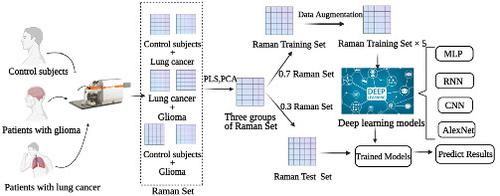当前位置:
X-MOL 学术
›
J. Raman Spectrosc.
›
论文详情
Our official English website, www.x-mol.net, welcomes your
feedback! (Note: you will need to create a separate account there.)
Rapid diagnosis of lung cancer and glioma based on serum Raman spectroscopy combined with deep learning
Journal of Raman Spectroscopy ( IF 2.4 ) Pub Date : 2021-08-09 , DOI: 10.1002/jrs.6224 Chen Chen 1, 2 , Wei Wu 3 , Cheng Chen 1, 2 , Fangfang Chen 1 , Xiaogang Dong 4 , Mingrui Ma 5 , Ziwei Yan 1, 2 , Xiaoyi Lv 2, 3 , Yuhua Ma 6, 7 , Min Zhu 7, 8
Journal of Raman Spectroscopy ( IF 2.4 ) Pub Date : 2021-08-09 , DOI: 10.1002/jrs.6224 Chen Chen 1, 2 , Wei Wu 3 , Cheng Chen 1, 2 , Fangfang Chen 1 , Xiaogang Dong 4 , Mingrui Ma 5 , Ziwei Yan 1, 2 , Xiaoyi Lv 2, 3 , Yuhua Ma 6, 7 , Min Zhu 7, 8
Affiliation

|
Lung cancer and glioma are common malignancies worldwide and pose a serious threat to human health. There may be a certain correlation between lung cancer patients and glioma patients in serum composition, but to date, no study on the classification and correlation of lung cancer and glioma is available. In this paper, the differences and relationships between lung cancer and glioma were analyzed from serum Raman spectra. The existing detection methods of lung cancer and glioma are time consuming and expensive, so we propose a method based on patient serum Raman spectra combined with deep learning, which can screen lung cancer and glioma accurately with speed and low cost. In this study, features were extracted from the original spectral data of patients with lung cancer, glioma, and control subjects. By adding different decibels of white Gaussian noise to the training set for data enhancement, the enhanced training set data were imported into a multilayer perceptron (MLP), recursive neural network (RNN), convolutional neural network (CNN), and AlexNet using fivefold cross-validation to build the diagnostic model. The results show that PLS-AlexNet is the best model. The accuracy of this model in the binary classification experiment of lung cancer and control subjects, lung cancer and glioma, and glioma and control subjects were 99%, 95.2%, and 100%, respectively, and the experimental accuracy of the AlexNet triclassification algorithm is also above 85%. This method has great potential in clinical diagnosis of diseases.
中文翻译:

基于血清拉曼光谱结合深度学习的肺癌和胶质瘤快速诊断
肺癌和胶质瘤是世界范围内常见的恶性肿瘤,对人类健康构成严重威胁。肺癌患者与胶质瘤患者的血清成分可能存在一定的相关性,但目前尚无肺癌与胶质瘤的分类及相关性研究。本文从血清拉曼光谱分析肺癌与胶质瘤的差异和关系。现有的肺癌和胶质瘤检测方法费时费力,因此我们提出了一种基于患者血清拉曼光谱结合深度学习的方法,可以快速、低成本地准确筛查肺癌和胶质瘤。在这项研究中,特征是从肺癌患者、胶质瘤患者和对照受试者的原始光谱数据中提取的。通过在训练集中添加不同分贝的高斯白噪声进行数据增强,将增强后的训练集数据导入多层感知器(MLP)、递归神经网络(RNN)、卷积神经网络(CNN)和使用五重交叉的AlexNet -验证以构建诊断模型。结果表明,PLS-AlexNet 是最好的模型。该模型在肺癌与对照受试者、肺癌与胶质瘤、胶质瘤与对照受试者二元分类实验中的准确率分别为99%、95.2%和100%,AlexNet三分类算法的实验准确率为也在 85% 以上。该方法在疾病的临床诊断中具有很大的潜力。递归神经网络 (RNN)、卷积神经网络 (CNN) 和 AlexNet 使用五重交叉验证来构建诊断模型。结果表明,PLS-AlexNet 是最好的模型。该模型在肺癌与对照受试者、肺癌与胶质瘤、胶质瘤与对照受试者二元分类实验中的准确率分别为99%、95.2%和100%,AlexNet三分类算法的实验准确率为也在 85% 以上。该方法在疾病的临床诊断中具有很大的潜力。递归神经网络 (RNN)、卷积神经网络 (CNN) 和 AlexNet 使用五重交叉验证来构建诊断模型。结果表明,PLS-AlexNet 是最好的模型。该模型在肺癌与对照受试者、肺癌与胶质瘤、胶质瘤与对照受试者二元分类实验中的准确率分别为99%、95.2%和100%,AlexNet三分类算法的实验准确率为也在 85% 以上。该方法在疾病的临床诊断中具有很大的潜力。肺癌和神经胶质瘤、神经胶质瘤和对照组分别为99%、95.2%和100%,AlexNet三分类算法的实验准确率也在85%以上。该方法在疾病的临床诊断中具有很大的潜力。肺癌和神经胶质瘤、神经胶质瘤和对照组分别为99%、95.2%和100%,AlexNet三分类算法的实验准确率也在85%以上。该方法在疾病的临床诊断中具有很大的潜力。
更新日期:2021-08-09
中文翻译:

基于血清拉曼光谱结合深度学习的肺癌和胶质瘤快速诊断
肺癌和胶质瘤是世界范围内常见的恶性肿瘤,对人类健康构成严重威胁。肺癌患者与胶质瘤患者的血清成分可能存在一定的相关性,但目前尚无肺癌与胶质瘤的分类及相关性研究。本文从血清拉曼光谱分析肺癌与胶质瘤的差异和关系。现有的肺癌和胶质瘤检测方法费时费力,因此我们提出了一种基于患者血清拉曼光谱结合深度学习的方法,可以快速、低成本地准确筛查肺癌和胶质瘤。在这项研究中,特征是从肺癌患者、胶质瘤患者和对照受试者的原始光谱数据中提取的。通过在训练集中添加不同分贝的高斯白噪声进行数据增强,将增强后的训练集数据导入多层感知器(MLP)、递归神经网络(RNN)、卷积神经网络(CNN)和使用五重交叉的AlexNet -验证以构建诊断模型。结果表明,PLS-AlexNet 是最好的模型。该模型在肺癌与对照受试者、肺癌与胶质瘤、胶质瘤与对照受试者二元分类实验中的准确率分别为99%、95.2%和100%,AlexNet三分类算法的实验准确率为也在 85% 以上。该方法在疾病的临床诊断中具有很大的潜力。递归神经网络 (RNN)、卷积神经网络 (CNN) 和 AlexNet 使用五重交叉验证来构建诊断模型。结果表明,PLS-AlexNet 是最好的模型。该模型在肺癌与对照受试者、肺癌与胶质瘤、胶质瘤与对照受试者二元分类实验中的准确率分别为99%、95.2%和100%,AlexNet三分类算法的实验准确率为也在 85% 以上。该方法在疾病的临床诊断中具有很大的潜力。递归神经网络 (RNN)、卷积神经网络 (CNN) 和 AlexNet 使用五重交叉验证来构建诊断模型。结果表明,PLS-AlexNet 是最好的模型。该模型在肺癌与对照受试者、肺癌与胶质瘤、胶质瘤与对照受试者二元分类实验中的准确率分别为99%、95.2%和100%,AlexNet三分类算法的实验准确率为也在 85% 以上。该方法在疾病的临床诊断中具有很大的潜力。肺癌和神经胶质瘤、神经胶质瘤和对照组分别为99%、95.2%和100%,AlexNet三分类算法的实验准确率也在85%以上。该方法在疾病的临床诊断中具有很大的潜力。肺癌和神经胶质瘤、神经胶质瘤和对照组分别为99%、95.2%和100%,AlexNet三分类算法的实验准确率也在85%以上。该方法在疾病的临床诊断中具有很大的潜力。









































 京公网安备 11010802027423号
京公网安备 11010802027423号